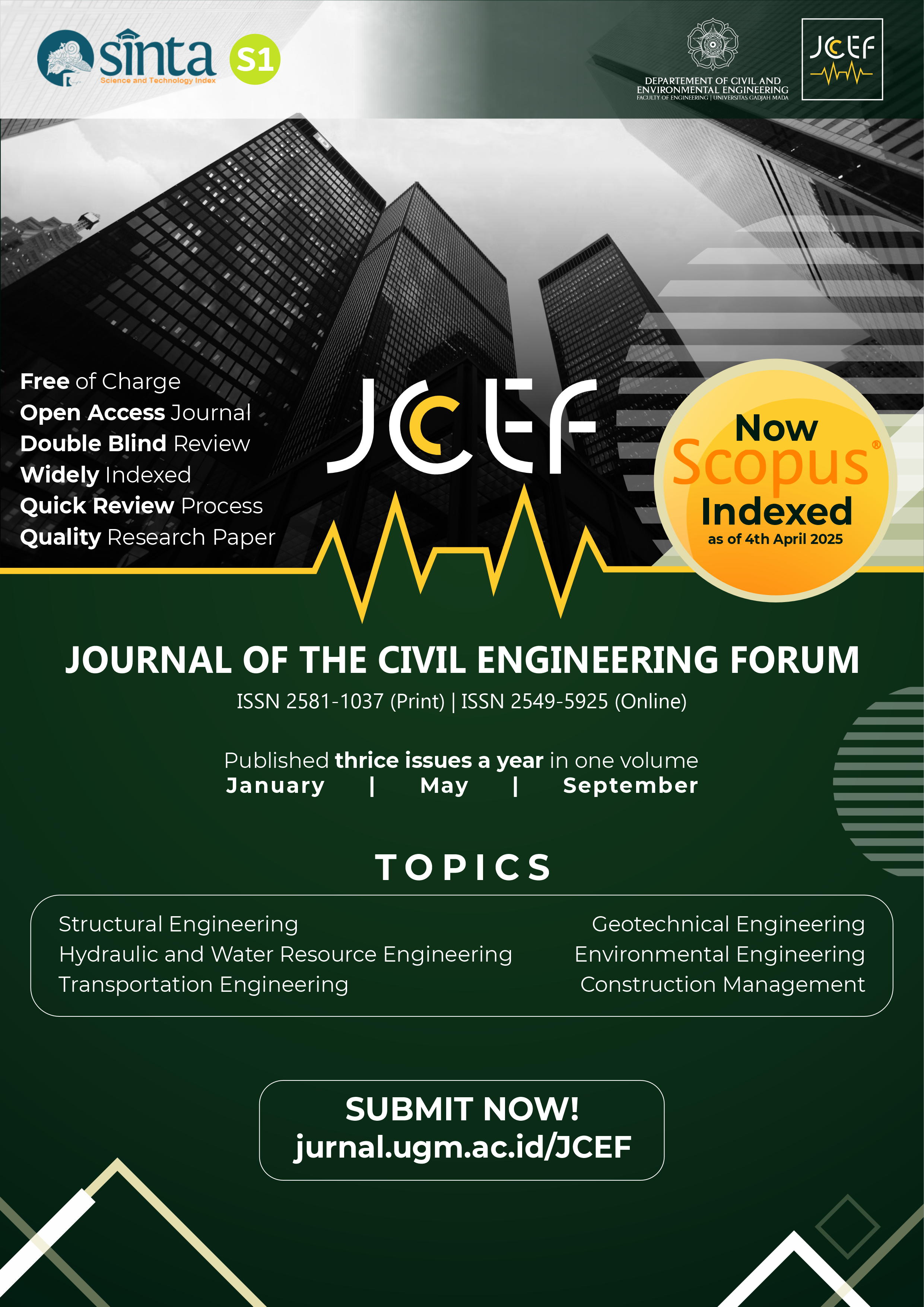Pore Pressure Responses of Liquefied Numerical Sand Columns
Abstract
The Palu 28 September 2021 M 7.5 Earthquake has brought several new challenges to the understanding of liquefaction and its following geotechnical phenomena. In addition, that main shock was followed by a series of aftershocks within a short time frame. The common geotechnical conditions of Palu area include layered soils conditions, and the associated variability of geotechnical conditions exists. This paper reports the dynamic effective stress analysis (ESA) study of four different liquefiable layered sand columns, and the above three conditions (layered soils, variability, aftershocks) are explicitly modeled. The dynamic ESA employs the PM4Sand constitutive model for liquefiable sands, implemented in the OpenSees platform. Three ground motion sets (“main shock only”, “main shock plus aftershock”, “aftershock” only) of variable amplitude, single frequency harmonic motions are used. The models are validated by comparing qualitatively their results against laboratory test results and field measurements. The saturated sand layers in all cases subjected to “main shock only” are liquefied with different detailed excess pore pressure (EPP) responses, highlighting the importance of the system response of liquefying sand columns. The cases subjected to “main shock plus aftershock” show a much a longer higher EPP state, while cases subjected to both “main shock plus aftershock” and “aftershock only” indicate a longer liquefaction state during the aftershock. The implication of the longer duration in the higher EPP state and the longer liquefaction state is that a longer duration of lower shear strength conditions would exist. The different EPP responses resulted from different geotechnical conditions represented by the four sand columns suggest that the variability of geotechnical conditions would have an important influence on the system response.
References
Andersen, K.H., Schjetne, K., 2013. Database of Friction Angles of Sand and Consolidation Characteristics of Sand, Silt, and Clay. Journal of Geotechnical & Geoenvironmental Engineering, 139(7): 1140-1155. https://doi.org/10.1061/(ASCE)GT.1943-5606.0000839
Boulanger, R., & Ziotopoulou, K., 2017. PM4Sand (version 3.1): A Sand Plasticity Model for Earthquake Engineering Applications. Davis, CA: Univ. of California.
Cubrinovski, M., Rhodes, A., Ntritsos, N., Van Ballegooy S., 2019. System response of liquefiable deposits. Soil Dynamics and Earthquake Engineering, 124:212–229. https://doi.org/10.1016/j.soildyn.2018.05.013
Gallant, A.P., Montgomery, J., Mason, H.B., Hutabarat, D., Reed, A.N., Wartman, J., Irsyam, M., Simatupang, P.T., Alatas, I.M., Prakoso, W.A., Djarwadi, D., Hanifa, R., Rahardjo, P., Faizal, L., Harnanto, D.S., Kawanda, A., A., Himawan, A. & Yasin, W., 2020. The Sibalaya flowslide initiated by the 28 September 2018 MW 7.5 Palu-Donggala, Indonesia earthquake. Landslides, 17:1925–1934. https://doi.org/10.1007/s10346-020-01354-1
Harninto, D.S., & Prakoso, W.A., 2020. Existence of Silt Seam Layer Triggering Flow Liquefaction on the Palu Mw 7.5 Earthquake 2018. Melbourne, 10th International Conference on Geotechnique, Construction Materials and Environment.
Hutabarat, D. & Bray, J.D., 2021a. Effective Stress Analysis of Liquefiable Sites to Estimate the Severity of Sediment Ejecta. Journal of Geotechnical & Geoenvironmental Engineering, 147(5):04021024. https://doi.org/10.1061/(ASCE)GT.1943-5606.0002503
Hutabarat, D. & Bray, J.D., 2021b. Seismic Response Characteristics of Liquefiable Sites with and without Sediment Ejecta Manifestation. Journal of Geotechnical & Geoenvironmental Engineering, 147(6): 04021040. https://doi.org/10.1061/(ASCE)GT.1943-5606.0002506
Kokusho, T. & Kojima, T., 2002. Mechanism for Postliquefaction Water Film Generation in Layered Sand. Journal of Geotechnical & Geoenvironmental Engineering, 128(2):129-137 https://doi.org/10.1061/(ASCE)1090-0241(2002)128:2(129))
Mason, H.B., Montgomery, J., Gallant, A.P., Hutabarat, D., Reed, A.N., Wartman, J., Irsyam, M., Simatupang, P.T., Alatas, I.M., Prakoso, W.A., Djarwadi, D., Hanifa, R., Rahardjo, P., Faizal, L., Harnanto, D.S., Kawanda, A., Himawan, A. & Yasin, W., 2021. East Palu Valley Flowslides Induced by the 2018 MW 7.5 Palu-Donggala Earthquake. Geomorphology, 373, pp. 107482. https://doi.org/10.1016/j.geomorph.2020.107482
Phoon, K.-K., Prakoso, W.A., Wang, Y., Ching, J., 2016, Uncertainty Representation of Geotechnical Design Parameters. In Reliability of Geotechnical Structures in ISO2394, Ed. K.K. Phoon, J.V. Retief, CRC Press.
Pramono, S., Prakoso, W.A., Cummins, P., Rahayu, A., Rudyanto, A., Syukur, F., Sofian, 2017. Investigation of Subsurface Characteristics by Using Parameters Vs30, HVSR and Combination of SPAC Method for Microtremor Array in Palu City and Surroundings. International Journal of Technology 8(6):983-992. https://doi.org/10.14716/ijtech.v8i6.682
Pramono, S., Prakoso, W.A., Rohadi, S., Karnawati, D., Santoso, E., Nurfajar, A., 2020. Influence of Seismicity Declustering on Ground Motion Prediction Equations for Central Sulawesi Seismic Region. International Journal of Geomate 19(71): 61–68. https://doi.org/10.21660/2020.71.28369
Prakoso, W.A., 2021. Survei dan Kajian Geoteknik Gempa Palu 28 September 2018. El-Markazi.
Rahayu, W., Nurizkatilah & Bahsan, E., 2020. Analysis of Liquefaction Potential in Lolu Village, Palu Using SPT Method and Laboratory Test of Grain Size Distribution. Bogor, International Seminar on Civil and Environmental Engineering. https://doi.org/10.1088/1755-1315/622/1/012016
Rahayu, W., Yuliyanti, I. & Bahsan, E., 2020. Analysis of Potential Liquefaction Using Cone Penetration Test Data and Grain Size Distribution Test with Case Study of Liquefaction in Lolu Village. Bogor, International Seminar on Civil and Environmental Engineering. https://doi.org/10.1088/1755-1315/622/1/012015
Ramdhiani, E., Prakoso, W.A., 2020. Cyclic Behaviour of Palu Sandy Soils in Cyclic Simple Shear Test. Solo, 7th International Conference on Engineering, Technology, and Industrial Application. https://doi.org/10.1088/1742-6596/1858/1/012039
Unjoh, S., Kaneko, M., Kataoka, S., Nagaya, K., Matsuoka, K., 2012. Effect of Earthquake Ground Motions on Soil Liquefaction, Soils and Foundations, 52(5):830–841. https://doi.org/10.1016/j.sandf.2012.11.006.
You, T.L., et al., 2001. Liquefaction Resistance of Soils: Summary Report from the 1996 NCEER and 1998 NCEER Workshops on Evaluation of Liquefaction Resistance of Soils, Journal of Geotechnical & Geoenvironmental Engineering, 127(10): 817–833. https://doi.org/10.1061/(ASCE)1090-0241(2001)127:10(817).
Copyright (c) 2022 The Author(s)

This work is licensed under a Creative Commons Attribution-ShareAlike 4.0 International License.
Copyright is granted to authors for the purpose of providing protection for articles written to describe experiments and their results. JCEF will protect and defend the work and reputation of the author and are also willing to address any allegations of violation, plagiarism, fraud, etc. against articles written and published by JCEF. JCEF is published under the terms of the Creative Commons Attribution-ShareAlike 4.0 International License (CC BY-SA 4.0). The author holds the copyright and assigns the journal rights to the first publication (online and print) of the work simultaneously.







